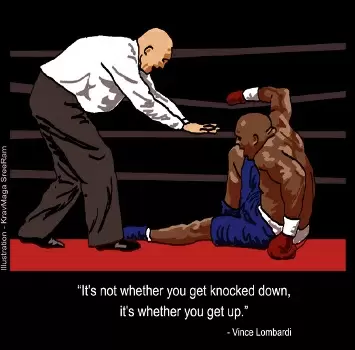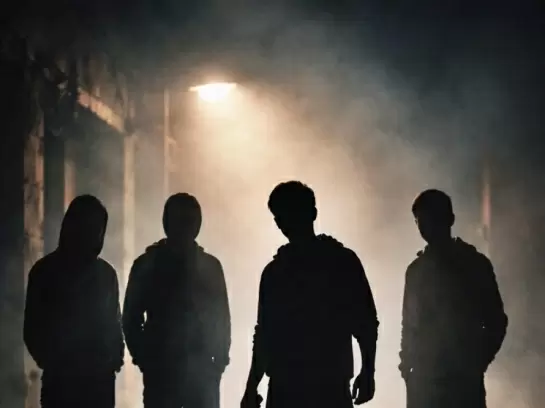All successful people and companies have failed miserably at some point or the other
30-December-2011
Vol 2 | Issue 52
If you describe yourself as the bankrupt also-ran, the sure-to-lose stooge, the dud that always flops, then welcome our dearest iconic failures, join the club of losers who will rule this century.
Loser! If that word stings you to the core of your heart, yet is the exact word that describes you completely, in every aspect, then this chapter is for you. Hello losers! You’ve reached this far – congratulations! Now allow us to usher you into this chapter hoping that you never forget the feeling of being a loser, and that you always hate every moment of it.
 |
|
Concept and Illustration by KravMaga Sreeram
|
Before you start cursing our ten generations and beyond, let us quickly take you through the story of a few losers who, for us, embody the spirit of despondent losers.
This boy from Syracuse (New York), was labelled a dyslexic when he was just seven. His friends would harass him, and his school teachers would humiliate him. This is how he describes his early days, “I’d try to concentrate on what I was reading, then I’d get to the end of the page and have very little memory of anything I’d read. I would go blank, feel anxious, nervous, bored, frustrated, dumb. I would get angry. My legs would actually hurt when I was studying. My head ached.” He went to three different high-schools and each time, he would try to hide his disability. Soon it would be discovered, and he would be sent off to remedial reading. He raised his hands very often in class, only to ensure that his teachers noticed him and gave him extra points so that he could just about make the passing grades. Even when he had to complete his homework, he would first dictate it to his elder sister, make her write it down, and then copy it word to word.
His parents got separated when he was just 12, and he along with his sister Lee Anne, moved with his mother to New Jersey, where she had to work in three jobs simultaneously to earn enough to feed the family. Everything in his life, besides playing baseball, soccer and football, seemed hopeless. He finally managed to clear high school but failed his undergrads as he was a “functional illiterate”. He loved to learn, wanted to learn but the dyslexia was debilitating (Many times, he would even forget that when the fuel gauge in the car falls to ‘E’, it needed refuelling). He decided to move to LA to become an actor. Even then, the loser in him found it hard to pass auditions, because he simply could not read the script. He started requesting others during the auditions to read the script and the directors to talk about the characters and the film. He wanted to give it all up many times, but whenever he did, all he remembered were his mother’s words – “You’ve got so much potential. Don’t give up.” In 1983, he landed his first starring role in the film Risky Business. He got noticed. Three years later, Top Gun was released, which grossed $343 million and made him a millionaire (he earned $2 million from the film)! Thomas Cruise Mapother IV is his name; Tom Cruise is how we know him – the winner of three Golden Globe Awards (and nominations for three Academy Awards). Tom Cruise, then a dyslexic with poor memory, and today, a certified-flying pilot, a millionaire- producer and one of Hollywood’s most powerful stars! And all that because the loser never gave up!
The second loser in our list was born to unwed, teenage parents at a farm in Mississippi. Her mother was an 18-year-old housemaid (named Vernita Lee), while her father was a 20-year-old freshman in the US army (named Vernon).
Soon after she was born, her parents decided to part ways, and she was left in the care of her grandmother, with whom she stayed till she was 6. Her childhood days could simply be described in three statements – she was a female, she was black, and she was very poor. As a child, she used to “playact” before an “audience” of farm animals. She was a bright kid though. On her first day at school, she left her kindergarten class after writing a note to her teacher, where she expressed her intent to study in the first grade. She was promoted to the third grade the very next year.
At the age of 6, she was sent to a very poor and dangerous neighborhood in Milwaukee, where she lived with her mother and two half-brothers. There, she was repeatedly raped by her cousin, her uncle and her mother’s friend. And her mother, because she worked odd jobs during odd hours, and because of their massively disadvantaged background, could frustratingly do nothing. The girl’s sufferings did not end there. She disintegrated into a habit of repeatedly skipping school, stealing money, and running away from home. Fed up, her mother then decided to put her into a detention home. As luck would have it, there were no openings in the home – and so she was sent to live with her father in Nashville. She became pregnant when she was 14, and gave birth to a dead baby.
Raped, humiliated, without any future, she was devastated, but she swore to herself that she would never give. Her father somehow aided her financially, and through sheer gut-wrenching effort, she became an excellent student at school and participated in the drama and debate clubs. The following year, she won a full scholarship to Tennessee State University (TSU) – and the following year, she was invited to a White House Conference on Youth. Subsequently, she was later given a job to read afternoon newscasts by a local Nashville radio station. When she became Miss Black Nashville and Miss Tennessee during her freshman year at TSU, Columbia Broadcasting System (CBS) offered her a job. And all this while she was still nineteen. She worked at various TV channels and got her biggest break in January 1984, when she became the anchor on a morning talk show called A.M. Chicago. Given the popularity of the show, 20 months later, it was renamed to ‘The Oprah Winfrey Show’. The black, poor, loser had been noticed and was already on her way to becoming a global celebrity. Today, she runs a production house (Harpo Inc.), is the richest black billionaire in the world (worth $2.7 billion) and most importantly, the second most powerful celebrity (behind Lady Gaga) in the world (as per Forbes 2011 ranking). And all because she never gave up!
The third loser in our list was born to Elias and Flora d’Isigny in Chicago’s Hermosa community area. His father was a farmer and a worker at a railroad company. As a young man, he was fired from the Kansas City Star newspaper.
Reason: his boss claimed that he lacked creativity. To fulfil his desire to become a full-time cartoonist, he started an animation company called Laugh-OGram Films in 1921. Though the start appeared bright (as he was able to raise $15,000 for the company), the New York distributor, with whom he had tied-up, went bankrupt. Result: end of Laugh-O-Gram. With a mountain of debt in his name, emotionally drained and financially broke, he barely earned a few dimes to pay his rent. Not able to afford proper food, this loser started eating dog food. But despite all that, there was one objective that the man nurtured all along, and that was to never give up.
By missing out on a few meals, he saved his last few dollars to buy a train ticket to Hollywood. And here, in 1926, he created an effervescent cartoon character named Oswald the Rabbit. When he tried to strike a deal with Universal Studios, without his knowledge, Universal went ahead and patented the Oswald character. Of course, the studio paid him nothing. He created more characters; but there were other rejections too. His Three Little Pigs concept was rejected for lack of more characters; filming of Pinocchio was stopped during production; his others creations like Bambi, Pollyanna and Fantasia were utterly disliked by viewers. Fighting against all odds and bankruptcy, the man went on to make the animation film Mary Poppins in 1944, which became a blockbuster hit.
Today, we all know this loser more because of Steamboat Willie, a cartoon character he made – a character that came to be later known as Mickey Mouse. Walt Disney was the name of this loser, who fought failure and sketched his road to success. Although he died in 1966, he left behind a legacy of never giving up. The company he co-founded, The Walt Disney Company, is today worth $55.98 billion (as on October 1, 2011) in the stock market!
The fourth loser in our story is a woman, whose life went into a massive disarray at an age when most of us are well settled. An English teacher in Portugal, she married a TV journalist. But just four months after the birth of her daughter, her husband separated from her. At wits’ end, she left her teaching job in Portugal and decided to be with her sister in Edinburgh, Scotland. Recovering from the divorce was still too painful and the lady kept struggling to make ends meet for herself and her year-old daughter. She had only government subsidies for support. She thought of teaching in Scotland too, but was soon rejected as in order to teach in Scotland, she required a ‘PGCE’ (postgraduate certificate of education). And then, she was diagnosed with clinical depression, and even thought of committing suicide.
Through all this, her one unwavering lighthouse was a book she was writing; a book which allowed her to escape all her miseries; a book which encompassed her spirit of fighting against the worst that life could offer and never giving up. Despite her miserable real life existence, she continued writing the book, spending time in many cafs. After completing the book, when she presented it to publishing house Bloomsbury in 1995, the owner asked her to “get a day job.” Twelve other publishers rejected the book; yet, she continued resolutely. A year later, the same publisher that had rejected her initially, Bloomsbury, offered her a measly £1500 advance for publishing rights in UK.
Although that money wasn’t enough at all, she didn’t give up. In 1997, she applied for grants from the Scottish Arts Council to enable her to continue writing. She received £8000 in return. And then, in 1998, Scholastic Inc. bought the US rights to publish her book for $105,000. The book came to be known as Harry Potter and the Philosopher’s Stone.
And she is Joanne K Rowling, the world’s richest author, worth over $1 billion. Following are the excerpts from a speech that Rowling delivered to graduates at HBS two years back – “A mere seven years after my graduation day, I had failed on an epic scale. An exceptionally short-lived marriage had imploded, and I was jobless, a lone parent, and as poor as it is possible to be in modern Britain, without being homeless... By every usual standard, I was the biggest failure. Failure meant a stripping away of the inessential. I stopped pretending to myself that I was anything other than what I was, and began to direct all my energy into finishing the only work that mattered to me... And so rock bottom became the solid foundation on which I rebuilt my life. I was the biggest failure I knew. Failure gave me an inner security that I had never attained by passing examinations. Failure taught me things about myself that I could have learned no other way.” Her books have so far sold more than 400 million copies and her last four titles of Harry Potter have consecutively set world records as the fastest selling novels in the world. Today, the Harry Potter brand is alone worth $15 billion, with the seven Potter films having grossed close to $5 billion! All because the loser Rowling decided to not give up.
Failures are the stepping stones to success. And this is as true for companies as they are for corporations. In an article contributed by Carmen Nobel, Senior Editor of HBS Working Knowledge, to Business & Economy magazine, she writes, “Most companies fail. It’s an unsettling fact for bright-eyed entrepreneurs, but old news to start-up veterans. But here’s the good news: Experienced entrepreneurs know that running a company that eventually fails can actually help a career, but only if the executives are willing to view failure as a potential for improvement. The statistics are disheartening no matter how an entrepreneur defines failure. If failure means liquidating all assets, with investors losing most or all the money they put into the company, then the failure rate for start-ups is 30 to 40 percent, according to Shikhar Ghosh, a senior lecturer at Harvard Business School who has held top executive positions at some eight technology-based start-ups. If failure refers to failing to see the projected return on investment, then the failure rate is 70 to 80 percent. And if failure is defined as declaring a projection and then falling short of meeting it, then the failure rate is a whopping 90 to 95 percent. Very few companies achieve their initial projections... Failure is the norm.”
 |
|
Arindam Chaudhuri (Photo: The Sunday Indian)
|
He was born at an underprivileged medical center. Even as a baby, life was anything but sweet for him. His parents divorced within three years of his birth. Although his mother remarried, she unfortunately married a man who was known to be jobless, and who got into the habit of coming home drunk every night – in fact, during a drunk-driving incident, the man had both his legs amputated and died soon after. As a young lad, struggling to keep up with social questions about his multiracial heritage, he became addicted to alcohol, marijuana and cocaine during his teenage years, which he later said was his “greatest moral failure.” He also became an uncontrollable chain smoker who couldn’t quit smoking despite trying too many times. He even lost his mother to ovarian cancer in 1995, much before he had anything signify cant to achieve. But failures are what taught this man the beautiful attitude of sincerity.
That belief is what led Barack Obama to win the Illinois senator seat in 1997; that belief is what led him to convince a totally opposed state assembly to pass a bill that forced police to videotape all interrogations to reduce torture and deaths in custody, especially of blacks; that belief is what led him to run the Presidential elections in 2008 despite being trounced devastatingly in the 2000 Congressional elections and despite being told a few years back by his media consultant that he stood very little chance as his name sounded too similar to Osama Bin Laden.
If Obama had had an underprivileged childhood, the late Steve Jobs went through worse. We might be repeating his example, but that’s the wonder of this single man, who made a world of difference to all of us.
When Steve Jobs was born, his mother was an unwed graduate student who put him up immediately for adoption as she did not wish to rear him. Ironically, Steve wasn’t even the first choice of his adoptive parents as they had actually wanted a girl. Steve’s ‘new’ mother was just a high school pass-out, and his father wasn’t even that. Later on in life, Steve Jobs did join college, but dropped out within six months as he couldn’t see the value in it. But despite dropping out, Jobs continued dropping into classes that interested him. He would sleep on the floor of his friends’ rooms and returned Coke bottles to earn 5 cents per bottle to buy food. Every Sunday night, he would walk seven miles across town to get a free meal at a Hare Krishna temple. The learning from that part of his life and those ‘dropout’ classes is what gave him the zeal to co-found Apple in 1976, market its Mac products too passionately, and make the cover of the TIME magazine by the age of 26. It’s common knowledge now how Steve Jobs was fired from his own company by Apple’s board of directors, a failure that drove him again to found Pixar and NeXT, two more iconic companies, before he was reinstated storybook style as Apple’s CEO! A pancreatic cancer patient (one of the most dangerous cancers with the lowest survival rates), Steve Jobs also had a liver transplant in 2009. Despite this he joined back for work!
“Living every day as the last day of your life,” is the very statement that drove his ambitions through all his failures since the age of 17, till the last day of his life, October 5, 2011.
From Milton Hershey of Hershey Chocolate Company (whose businesses went bankrupt three times before he finally made it big), Henry Ford (who failed twice before Ford Motor Corporation was born) to Abraham Lincoln (who lost seven times in the Presidential elections before he finally made it), all successful people have been the biggest failures at one point or the other in their lifetimes.
Finally, we come to the last loser – and that is you! Every person in this world has had failures, some small, some big.
There is no individual on this planet who has been a born winner and none who has never experienced any failure – from Steve Jobs to Bill Gates to Mahatma Gandhi to Nelson Mandela, all legendary icons have been as legendary in being failures at some point or the other in their lives. But the one common quality amongst all of them has been, that they’ve never given up. The resolve to fight each failure – however harsh it might be – with conviction is the attitude that these losers have had. And that’s exactly the attitude that you should cherish for your future. Failing is the norm – what separates winners from losers is their attitude and what they learn from their failures. If you want to be a successful leader, develop the winning attitude of the world’s greatest losers.
May you not be the biggest example of success ever, but be the biggest example of how to fight the worst failures.
May you succeed in inculcating the right loser’s attitude. May you always be the loser that we wish you to be.
(Excerpted from the book, ‘Cult’ by Arindam Chaudhuri, Editor-in-chief, The Sunday Indian and A Sandeep, Group Editor of Planman Media)
By arrangement with The Sunday Indian















